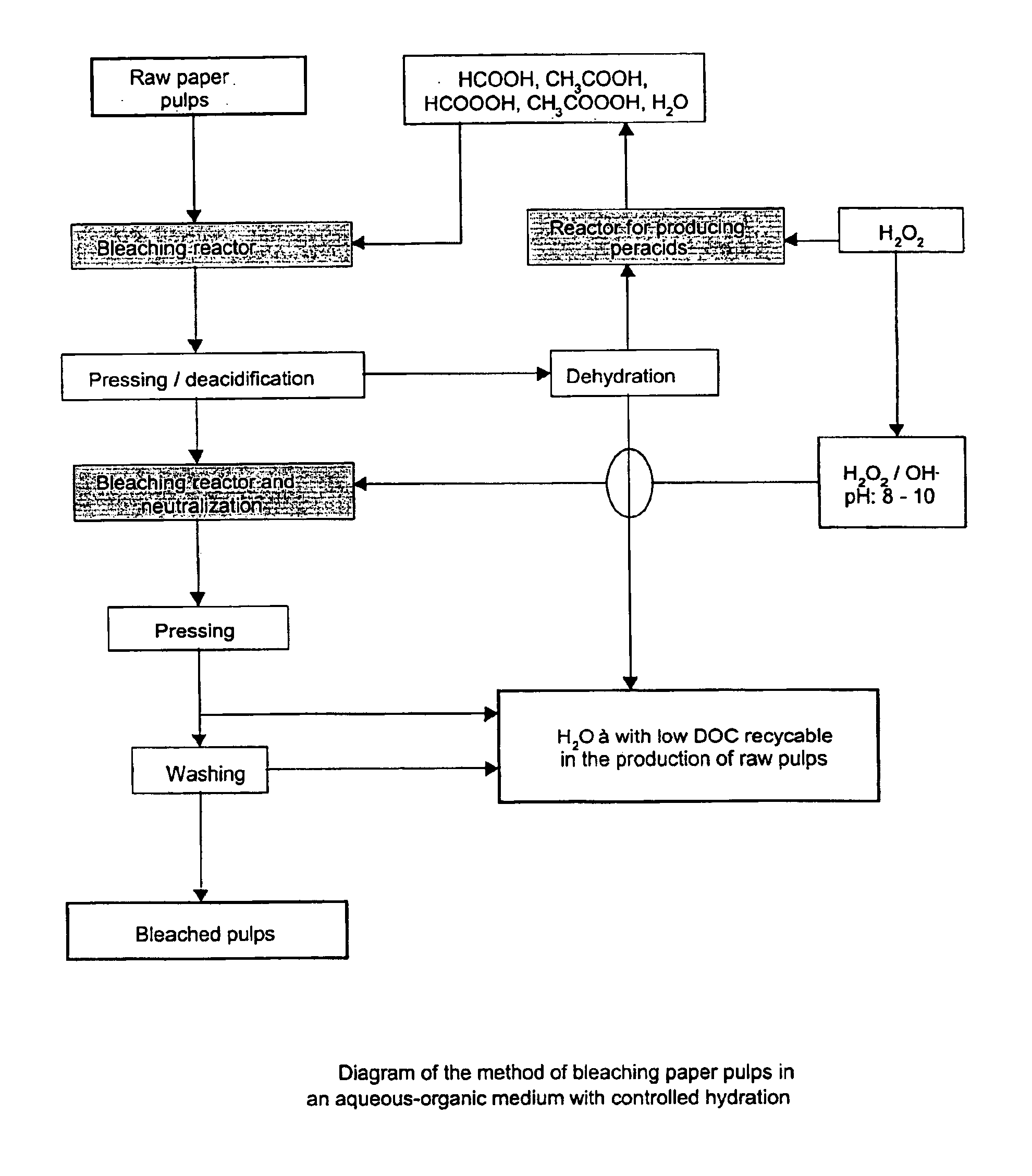Method for bleaching paper pulp with organic peracids followed by peroxide and sodium hydroxide
a paper pulp and organic peracid technology, applied in the field of paper pulp bleaching, can solve the problems of degradation of the mechanical qualities of the paper pulp thus treated, difficulty in controlling reactivity, and high water use quantity, and achieve stable and neutral, even very slightly basic, low degree of polymerization
- Summary
- Abstract
- Description
- Claims
- Application Information
AI Technical Summary
Benefits of technology
Problems solved by technology
Method used
Image
Examples
example 1
[0067]Bleaching of pulps from wheat straw
[0068]50 grams of air-dried wheat straw are delignified in an organic acid medium under the conditions described in French patent No. 97 13658 of Oct. 30, 1997 (publication No. 2 770 543).
[0069]When the cooking is complete, the pulp obtained (25 grams of dry matter having a kappa value of 30 and a degree of polymerization of 1 450) is manually pressed and brought into contact with 500 cm3 of a solution of acetic and formic acid and of peracetic and performic acids having an acetic acid+peracetic acid / formic acid+performic acid ratio of 9 / 1 by volume.
[0070]The peracids are prepared by bringing the acetic and formic acids into contact with hydrogen peroxide having a concentration of 50% by weight minimum (temperature 60° C., duration 3 hours).
[0071]The concentration of hydrogen peroxide is of the order of 0.35 mol per liter of mixture of organic acids.
[0072]The water content of the raw pulps is less than 10% by weight.
[0073]The suspension is ke...
example no.2
EXAMPLE NO. 2
[0085]50 grams of straw are treated as in example No. 1.
[0086]The bleaching of the raw straw pulp (kappa value 30, degree of polymerization: 1,450) in acidic medium is carried out as in example No. 1.
[0087]After filtration of the pulps and manual pressing in order to recover the maximum amount of acids, peracids and residual hydrogen peroxide, the pulps are degassed under vacuum in a rotary evaporator.
[0088]The pressure is kept at a mean value of 25 Kpa.
[0089]The temperature varies from 60° C. to 80° C. from the beginning to the end of the evaporation phase.
[0090]This makes it possible to recover condensates with different concentrations of organic acids and of peracids.
[0091]The hydrogen peroxide is mostly present in the pulps after evaporation of the acids.
[0092]After this evaporation stage, the pulps are brought into contact with a sodium hydroxide solution (pH 10) with a liquid / solid ratio of 7 / 1.
[0093]The treatment temperature is 95° C.
[0094]The duration of treatme...
example no.3
EXAMPLE NO. 3
[0098]Bleaching of raw industrial kraft pulps from resinous wood.
[0099]25 grams of raw industrial kraft pulps from resinous wood (kappa value of 35, degree of polymerization of 1,500), air-dried, are mixed with 100 cc of a mixture of acetic, formic, peracetic and performic acids which is prepared as in example No. 1.
[0100]The peracids are prepared by bringing the acetic and formic acids into contact with hydrogen peroxide having a concentration of 50% by weight minimum (temperature 60° C., duration 3 hours).
[0101]The concentration of hydrogen peroxide is of the order of 0.35 mol per liter of mixture of organic acids.
[0102]The water content of the raw pulps is less than 10% by weight.
[0103]The suspension is kept at 70° C. for 2 hours 30 minutes.
[0104]The pulp is then filtered, manually pressed and washed with distilled water.
[0105]The peracids and hydrogen peroxide are assayed.
[0106]The concentration of peracids in the acids recovered is 0.18 mol per liter, while this co...
PUM
| Property | Measurement | Unit |
|---|---|---|
| Temperature | aaaaa | aaaaa |
| Temperature | aaaaa | aaaaa |
| Temperature | aaaaa | aaaaa |
Abstract
Description
Claims
Application Information
 Login to View More
Login to View More - R&D
- Intellectual Property
- Life Sciences
- Materials
- Tech Scout
- Unparalleled Data Quality
- Higher Quality Content
- 60% Fewer Hallucinations
Browse by: Latest US Patents, China's latest patents, Technical Efficacy Thesaurus, Application Domain, Technology Topic, Popular Technical Reports.
© 2025 PatSnap. All rights reserved.Legal|Privacy policy|Modern Slavery Act Transparency Statement|Sitemap|About US| Contact US: help@patsnap.com


